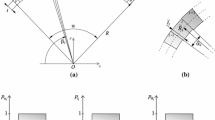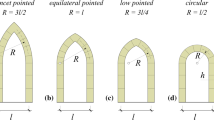Abstract
In this paper, we compute the location of the imminent hinges and the minimum thickness, t, of a circular masonry arch with mid-thickness radius, R, and embracing angle, β, which can just sustain its own weight together with a given level of a horizontal ground acceleration, ε g. Motivated from the recent growing interest in identifying the limit equilibrium states of historic structures in earthquake prone areas, this paper shows that the value of the minimum horizontal acceleration that is needed to convert an arch with slenderness (t/R, β) into a four-hinge mechanism depends on the direction of the rupture at the imminent hinge locations. This result is obtained with a variational formulation and the application of the principle of stationary potential energy, and it is shown that a circular arch becomes a mechanism with vertical ruptures when subjected to a horizontal ground acceleration that is slightly lower than the horizontal acceleration needed to create a mechanism with radial ruptures. The paper explains that the multiplicity on the solution for the minimum uplift acceleration is a direct consequence of the multiple possible ways that a masonry arch with finite thickness may rupture at a given location. The paper further confirms that the results obtained with commercially available distinct element software are in very good agreement with the rigorous solution.
Similar content being viewed by others
References
Couplet, P.: De la poussée des voûtes. Histoire de l’Académie Royale des Sciences, Paris (1729, 1730)
Milankovitch, M.: Beitrag zur Theorie der Druckkurven. Dissertation zur Erlangung der Doktorwürde, K.K. technische Hochschule, Vienna (1904)
Milankovitch M.: Theorie der Druckkurven. Zeitschrift für Mathematik und Physik 55, 1–27 (1907)
Heyman J.: The safety of masonry arches. Int. J. Mech. Sci. 11, 363–385 (1969). doi:10.1016/0020-7403(69)90070-8
Foce F.: On the safety of the masonry arch. Different formulations from the history of structural mechanics. In: Huerta, S. (ed.) Essays in the History of Theory of Structures, pp. 117–142. Instituto Juan de Herrera, Madrid (2005)
Foce F.: Milankovitch’s Theorie der Druckkurven: good mechanics for masonry architecture. Nexus Netw. J. 9, 185–210 (2007). doi:10.1007/s00004-007-0039-9
Albuerne, A., Huerta, S.: Coulomb’s theory of arches in Spain ca. 1800: the manuscript of Joaquín Monasterio. In: Chen, B., Wei, J. (eds.) In: Proc. 6th Int. Conf. on Arch Bridges (ARCH’10). Fuzhou, China, pp. 354–362 (2010)
Oppenheim I.J.: The masonry arch as a four-link mechanism under base motion. Earthq. Eng. Struct. Dyn. 21, 1005–1017 (1992). doi:10.1002/eqe.4290211105
Konstantinidis D., Makris N.: Experimental and analytical studies on the response of freestanding laboratory equipment to earthquake shaking. Earthq. Eng. Struct. Dyn. 38, 827–848 (2009). doi:10.1002/eqe.871
Makris N., Vassiliou M.F.: Sizing the slenderness of free-standing rocking columns to withstand earthquake shaking. Arch. Appl. Mech. 82, 1497–1511 (2012). doi:10.1007/s00419-012-0681-x
Makris N., Vassiliou M.F.: Planar rocking response and stability analysis of an array of free-standing columns capped with a freely supported rigid beam. Earthq. Eng. Struct. Dyn. 42, 431–449 (2013). doi:10.1002/eqe.2222
Clemente P.: Introduction to dynamics of stone arches. Earthq. Eng. Struct. Dyn. 27, 513–522 (1998). doi:10.1002/(SICI)1096-9845(199805)27:5 < 513::AID-EQE740 > 3.0.CO;2-O
De Lorenzis L., DeJong M., Ochsendorf J.: Failure of masonry arches under impulse base motion. Earthq. Eng. Struct. Dyn. 36, 2119–2136 (2007). doi:10.1002/eqe.719
De Jong M., De Lorenzis L., Adams S., Ochsendorf J.: Rocking stability of masonry arches in seismic regions. Earthq. Spectra 24, 847–865 (2008). doi:10.1193/1.2985763
De Luca A., Giordano A., Mele E.: A simplified procedure for assessing the seismic capacity of masonry arches. Eng. Struct. 26, 1915–1929 (2004). doi:10.1016/j.engstruct.2004.07.003
Ochsendorf, J.: Collapse of Masonry Structures. PhD Dissertation, Department of Engineering, University of Cambridge, Cambridge (2002)
Makris, N., Alexakis, H.: From Hooke’s “Hanging Chain” and Milankovitch’s “Druckkurven” to a Variational Formulation: The Adventure of the Thrust-Line of Masonry Arches. Report series in EEAM 2012-02. University of Patras, Greece (2012)
Makris N., Alexakis H.: The effect of stereotomy on the shape of the thrust-line and the minimum thickness of semicircular masonry arches. Arch. Appl. Mech. 83, 1511–1533 (2013). doi:10.1007/s00419-013-0763-4
Alexakis H., Makris N.: Minimum thickness of elliptical masonry arches. Acta Mech. 224, 2977–2991 (2013). doi:10.1007/s00707-013-0906-2
Lamé M.G., Clapeyron E.: Mémoire sur la stabilité des voûtes. Annales des mines 8, 789–836 (1823)
Timoshenko S.P.: History of Strength of Materials. McGraw-Hill, New York (1953)
Heyman, J.: La Coupe des Pierres. In: Kurrer, K.E., Lorenz, W., Wetzk, V. (eds.) Proc. 3rd Int. Cong. on Construction History. Neunplus1, Berlin, 2, pp. 807–812 (2009)
Gaß S.: IL 25: Experiments. University of Lightweight Structures. Institute for Lightweight Structures, Germany (1990)
De Jong, M.: Seismic Assessment Strategies for Masonry Structures. PhD dissertation. Department of Architecture. Massachusetts Institute of Technology, USA (2009)
Shames I.H., Dym C.L.: Energy and Finite Elements Methods in Structural Mechanics. Hemisphere Publishing Corporation, New York (1985)
UDEC: Universal Distinct Element Code, v.4.0. Itasca Consulting Group, Inc., Minneapolis (2004)
Sinopoli A., Corradi M., Foce F.: Modern formulation for preelastic theories on masonry arches. J. Eng. Mech. 123, 204–213 (1997). doi:10.1061/(ASCE)0733-9399(1997)123:3(204)
Alexakis H., Makris N.: Structural stability and bearing capacity analysis of the tunnel-entrance to the stadium of ancient Nemea. Int. J. Arch. Herit. 7, 673–692 (2013). doi:10.1080/15583058.2012.662262
Cundall, P.A.: A computer model for simulating progressive large-scale movements in blocky rock system. In: Proceedings of the Symposium of the International Society for Rock Mechanics, vol. I. Nancy, France, n.II-8 (1971)
Pagnoni T., Vanzi I.: Experimental and numerical study of the seismic response of block structures. In: Middleton, J., Pande, G.N. (eds.) Computer Methods in Structural Masonry, pp. 213–222. Books & Journals International, Swansea (1995)
Lemos J.V.: Assessment of the ultimate load of a masonry arch using discrete elements. In: Middleton, J., Pande, G.N. (eds.) Computer Methods in Structural Masonry, pp. 294–302. Books & Journals International, Swansea (1995)
Lemos J.V.: Discrete element modelling of masonry structures. Int. J. Arch. Herit. 1, 190–213 (2007). doi:10.1080/15583050601176868
Papantonopoulos C., Psycharis I.N., Papastamatiou D.Y., Lemos J.V., Mouzakis H.P.: Numerical prediction of the earthquake response of classical columns using the distinct element method. Earthq. Eng. Struct. Dyn. 31, 1699–1717 (2002). doi:10.1002/eqe.185
Author information
Authors and Affiliations
Corresponding author
Rights and permissions
About this article
Cite this article
Alexakis, H., Makris, N. Limit equilibrium analysis and the minimum thickness of circular masonry arches to withstand lateral inertial loading. Arch Appl Mech 84, 757–772 (2014). https://doi.org/10.1007/s00419-014-0831-4
Received:
Accepted:
Published:
Issue Date:
DOI: https://doi.org/10.1007/s00419-014-0831-4




